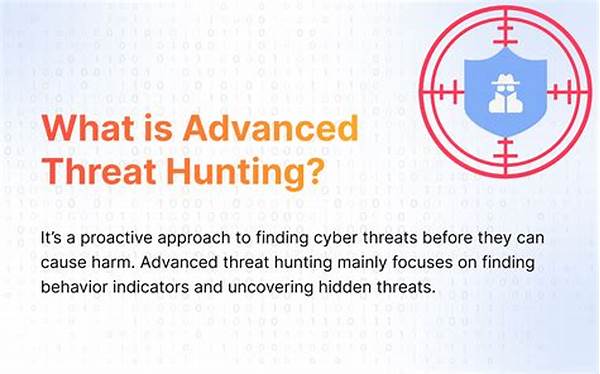In the ever-evolving landscape of cyber threats, organizations require a proactive approach to secure their digital assets. Gone are the days when businesses could rely solely on firewalls and antivirus software to thwart attacks. Today, cybercriminals are continually developing sophisticated techniques to infiltrate systems, making it imperative for organizations to adopt advanced threat hunting techniques. This approach involves continuously searching for threats within your network, even if those threats haven’t triggered an alert. It’s about staying a step ahead of hackers, identifying anomalies before they become full-blown breaches.
Advanced threat hunting is more than just a buzzword—it’s a necessity in today’s digital realm. It combines the best of both human intuition and machine learning, leveraging data analytics, artificial intelligence, and human intellect to spot and address threats proactively. With businesses increasingly moving their operations online, ensuring robust cybersecurity has never been more critical. Recent statistics have shown that companies employing advanced threat hunting techniques experience fewer breaches and faster remediation times, significantly reducing potential fallout from any cyber incursion.
Imagine your business as a bustling metropolis. Advanced threat hunting is akin to having a specialized task force roaming the streets, identifying suspicious activities before they turn into major crimes. It’s not about responding after the damage is done; it’s about forewarning and preventive measures. Every day, there are countless attempts by malicious actors aiming to compromise systems, making this proactive method not just beneficial but vital. The narrative here isn’t just technical; it’s a battle of wits against hackers.
Offered as exclusive services by cybersecurity firms, advanced threat hunting techniques provide peace of mind, knowing that your most sensitive data is relentlessly monitored by industry experts. Clients who’ve adopted this approach often share testimonials of how their businesses were saved from potential disasters, making it a compelling proposition for any company looking to fortified their cybersecurity ecosystem.
The Core of Advanced Threat Hunting
Advanced threat hunting techniques prioritize detecting abnormal activities that go beyond traditional rule-based alert systems. It’s about approaching cybersecurity with the mindset that threats might already be lurking within the system. This anticipation fuels an ongoing investigation, looking for telltale signs of compromise. By understanding patterns, employing behavioral analytics, and constantly updating threat intelligence, companies can maintain the upper hand against cyber adversaries.
—
Understanding Advanced Threat Hunting Techniques
In the realm of cybersecurity, the phrase “advanced threat hunting techniques” has emerged as a beacon of modern defense strategies. Organizations today face challenges more sophisticated than ever before. Delving deeper into this digital battleground, understanding what sets these techniques apart is crucial. They’re not merely the byproducts of technological evolution; they embody a paradigm shift in how businesses approach security.
The appeal of advanced threat hunting techniques lies in their proactive nature. Unlike the passive surveillance of traditional security methods, these strategies involve active pursuit of threats. They empower businesses to identify potential vulnerabilities before they are exploited, leveraging state-of-the-art technology and human expertise. When experts talk about “hunting,” it’s not just a figurative term—it’s a precise, calculated scan of digital environments, aimed at detecting undetected foes.
Statistically, businesses that integrate advanced threat hunting techniques report notable reductions in threat exposure. A study revealed that companies using these methods witnessed up to a 50% decrease in the impact of security incidents. This effectiveness stems from layered security postures, blending automation with human insight. By having teams continuously sift through logs and anomalies, potential threats are unearthed long before they could wreak havoc.
But it’s not only about dry statistics or tech jargon. The human element in advanced threat hunting techniques cannot be overstated. Expert hunters often share stories of how their efforts thwarted major threats, turning potential disasters into mere footnotes. These anecdotal successes add a layer of persuasiveness, emphasizing the value of these techniques beyond numbers and into the realm of real-world impact.
The Methodology Behind the Hunt
A crucial aspect of understanding advanced threat hunting techniques is recognizing the methodology. Typically, this involves several key actions that, collectively, create an impenetrable defense shield. From scrutinizing endpoint activities to leveraging the latest in AI algorithms, each component reveals a piece of the puzzle. This orchestration ensures threats are identified and neutralized with precision.
Each step in the methodology amplifies the efficacy of advanced threat hunting techniques, reinforcing their importance in any modern cybersecurity strategy. These actions serve as a blueprint for enterprises looking to heighten their defensive capabilities, ensuring they remain resilient amidst ever-evolving cyber threats.
—
Dive deeper into the discussion, and you’ll find that advanced threat hunting techniques offer rich insights into the ever-changing landscape of cybersecurity. As organizations develop intricate webs of networks and data streams, it becomes imperative to look beyond surface-level security measures. The depth and breadth of these techniques ensure that businesses are not only protecting themselves but are also setting industry standards for safety.
Advanced threat hunting techniques carve a niche by going beyond traditional endpoint protection. They venture into interconnected systems, looking at the bigger picture, identifying how threats evolve, and discovering countermeasures before attack vectors materialize. This is the crux of why so many organizations have started prioritizing these tactics, recognizing their prowess in keeping sensitive data secure.
Importantly, advanced threat hunting techniques also promote a culture of continuous learning and improvement. Through regular feedback loops and insights gathered from threat detection exercises, businesses evolve their defenses. Thus, they aren’t merely consumers of technology but rather active participants in the cybersecurity landscape, shaping their destinies by staying ahead of threats.

